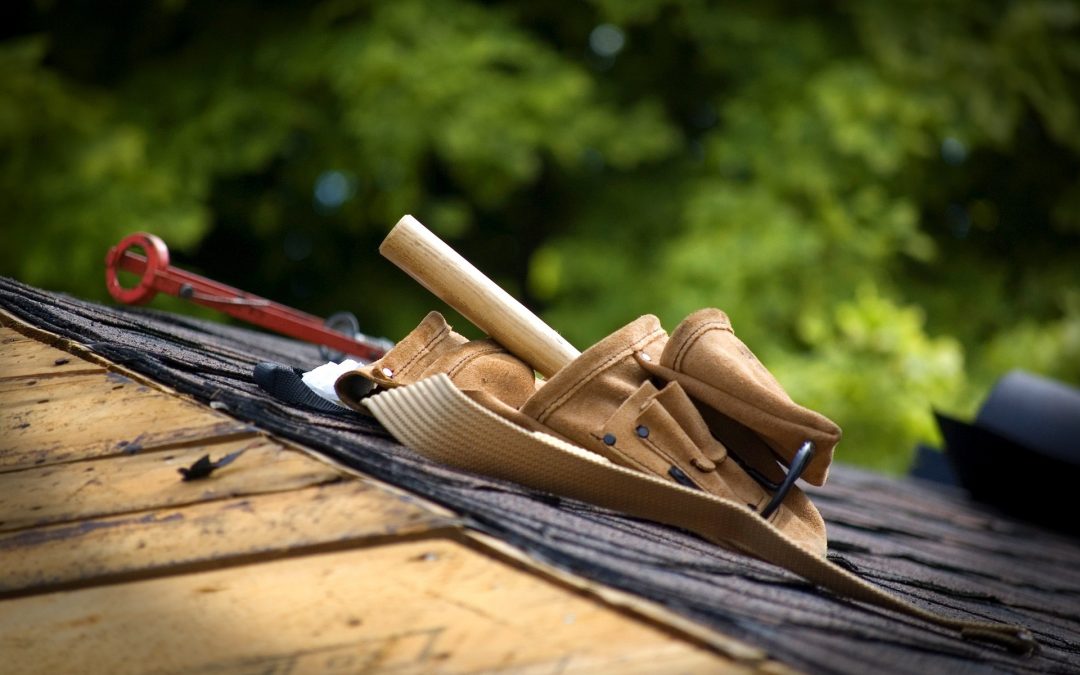Although homeowners aren’t necessarily expected to climb on their roofs every season as part of regular home maintenance, there are some conditions that should be monitored to prevent roof damage and to help you get the longest life out of your roof-covering materials. Certain types of damage can lead to water and pest intrusion, structural deterioration, and energy inefficiency.
Weathering
Hail and storm damage, known as weathering, can weaken a roof’s surface even if you haven’t lost any shingles/shakes/slates following a storm. It’s the most common source of environmental damage for roofs. Strong, sustained winds can cause uplift to the edges of shingles and shakes, which can weaken their points of attachment and allow rainwater and melting snow to reach the roof’s underlayment. Wind can also send projectiles through the air, which can damage every surface of the home’s exterior, including the roof. You should always inspect your roof after a heavy weather event, as far as it is practical to do so without taking any undue risks, to check whether you have lost any roof-covering materials, or if any parts look particularly weathered or damaged. A small fix now could prevent costly repairs later.
Tree Damage
Tree damage results from wind-blown tree branches scraping against shingles and from the impact of falling branches blown by wind and/or because the nearby tree has dead branches that eventually break off and fall. Branches that overhang the roof should always be cut back to avoid damage from both abrasion and impact, and to prevent the accumulation of leaf debris on the roof, its valleys, and in the gutters, which will interfere with proper drainage and lead to pooling of rainwater and snowmelt. Of course, it’s especially important to make sure that tree limbs near the home’s roof and exterior are a safe distance away from utility and power lines. Tree-trimming is a type of homeowner maintenance task should be undertaken by qualified professionals, as it can lead to accidentally cutting off the service or power from an overhead line, being electrocuted by an energized line, being struck by an unsecured tree branch, falling off the roof or a ladder, and any number of similar mishaps that the homeowner is not trained to anticipate and avoid.
Animal Damage
Squirrels and raccoons (and roof rats in coastal regions) will sometimes tear through shingles and roof sheathing when they’re searching for a protected area in which to build nests and raise their young. They often attack the roof’s eaves first, especially on homes that have suffered decay to the roof sheathing due to a lack of drip edges or from problems caused by ice damming, because decayed sheathing is softer and easier to tear through. If you hear any activity of wildlife on your roof, check inside your attic for evidence of pest intrusion, such as damaged insulation, which pests may use for nesting material. Darkened insulation generally indicates that excess air is blowing through some hole in the structure, leading the insulation to become darkened by dirt or moisture.
Biological Growth
Algae, moss and lichen are types of biological growth that may be found on asphalt shingles under certain conditions. Some professionals consider this growth destructive, while others consider it merely a cosmetic problem. Asphalt shingles may become discolored by both algae and moss, which spread by releasing airborne spores.
Almost all biological growth on shingles is related to the long-term presence of excess moisture, which is why these problems are more common in areas with significant rainfall and high relative humidity. But even in dry climates, roofs that are shaded most of the time can develop biological growth.
What we commonly call “algae” is actually not algae, but a type of bacteria capable of photosynthesis. Algae appears as dark streaks, which are actually the dark sheaths produced by the organisms to protect themselves from the ultraviolet radiation of the sun. When environmental conditions are right, the problem can spread quickly across a roof.
Algae can feed on mineral nutrients, such as the calcium carbonate in limestone used as asphalt shingle filler. Calcium carbonate also causes asphalt to retain moisture, which also promotes algae growth, so shingles with excessive filler may be more likely to suffer more algae growth. The rate of filler consumption is slow enough that it’s not generally considered a serious problem.
Algae attach to the shingle by secreting a substance that bonds it tightly to the surface. Growth can be difficult to remove without damaging the roof. The best method is prevention. Algae stains can sometimes be lightened in color by using special cleaners. Power-washing and heavy scrubbing may loosen or dislodge granules. Chemicals used for cleaning shingles may damage landscaping. Also, the cleaning process makes the roof wet and slippery, so such work should be performed by a qualified professional.
Moss is a greenish plant that can grow more thickly than algae. It attaches itself to the roof through a shallow root system that can be freed from shingles fairly easily with a brush. Moss deteriorates shingles by holding moisture against them, but this is a slow process. Moss is mostly a cosmetic issue and, like algae, can create hazardous conditions for those who climb on the roof.
Lichens are composite organisms consisting of a fungus and a photosynthetic partner, such as green or blue-green algae. Lichens bond tightly to the roof, and when they’re removed from asphalt shingles, they may take granules with them. Damage from lichen removal can resemble blistering.
“Tobacco-juicing” is the brownish discoloration that appears on the surface of shingles, under certain weather conditions. It’s often temporary and may have a couple of different causes. After especially long periods of intensely sunny days, damp nights and no rain, water-soluble compounds may leach out of the asphalt from the shingles and be deposited on the surface. Tobacco-juicing may also appear under the same weather conditions if the air is especially polluted. Tobacco-juicing won’t harm asphalt shingles, although it may run down the roof and stain siding. Although it’s more common in the West and Southwest, it can happen anywhere that weather conditions are right. You can spray-wash or paint the exterior of the home to remove tobacco-juicing.
For more home-maintenance tips, please click here https://greydoginspections.com/blog/
To learn more about Grey Dog Home Inspections, LLC, please click here https://greydoginspections.com/


Recent Comments